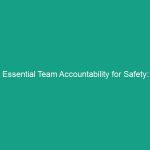Introduction
In today’s fast-paced world, the significance of Health, Safety, and Environment (HSE) practices cannot be overstated, especially in utility sectors. Utility Safety concerns the measures and Regulations aimed at preventing accidents and ensuring the well-being of workers and the community. The integration of strict Safety protocols is crucial in protecting employees and the public from potential Hazards associated with utilities, such as electricity, water, and gas. This article will delve into essential utility Safety Guidelines that help avoid critical risks, ensuring a safer work environment for everyone involved.
Understanding Utility Safety
Utility safety encompasses a broad spectrum of practices and regulations designed to mitigate risks associated with utilities. From Electrical Safety to the handling of hazardous materials, the importance of utility safety cannot be emphasized enough. Effective utility Safety Measures help in reducing workplace accidents, protecting the environment, and ensuring compliance with federal and state regulations. The primary keyword, utility safety, reflects the core focus of this article as we explore its various facets.
Defining Utility Safety
Utility safety refers to the protocols and practices that protect workers and the public from the Hazards associated with utility services. This includes working with high-voltage systems, managing water and gas pipelines, and handling hazardous waste. The primary goal of utility safety is to prevent accidents that can lead to injuries or fatalities, as well as environmental damage.
The Importance of Utility Safety
The relevance of utility safety extends beyond mere compliance with regulations; it is a fundamental aspect of corporate responsibility. Companies that prioritize safety not only protect their employees but also enhance their reputation and operational efficiency. Safety measures can lead to reduced insurance costs, lower employee turnover, and increased productivity. Moreover, a commitment to utility safety fosters a culture of safety within the organization, encouraging employees to adopt Safe Practices in their daily routines.
Regulatory Frameworks Governing Utility Safety
Understanding the regulatory frameworks that govern utility safety is essential for any organization involved in utility services. These regulations are designed to enforce Safe Practices and protect both workers and the public from potential hazards. Various organizations and governmental bodies play crucial roles in establishing and enforcing these regulations.
Key Regulatory Bodies
Numerous regulatory bodies oversee utility safety, including:
- Occupational Safety and Health Administration (OSHA): osha sets and enforces Standards to ensure safe working conditions for employees across various industries.
- Environmental Protection Agency (EPA): The EPA regulates environmental standards, particularly concerning hazardous materials and waste management.
- National Fire Protection Association (NFPA): The NFPA develops codes and standards to help prevent Fires and Electrical Hazards.
- Federal Energy Regulatory Commission (FERC): FERC regulates the interstate transmission of electricity, natural gas, and oil.
Compliance Requirements
Compliance with these regulations is not optional; it is a legal requirement. Organizations must regularly conduct safety audits and Training sessions to ensure they meet the established safety standards. Regular inspections and documentation are critical components of compliance, enabling organizations to identify potential weaknesses in their safety programs and address them proactively.
Best Practices for Utility Safety
Implementing Best Practices in utility safety is vital for minimizing risks. These practices can be divided into several key areas, including training, communication, and equipment Maintenance.
Training and Education
Training is the backbone of any effective safety program. Employees must be well-versed in safety protocols and emergency response Procedures. Regular training sessions should cover:
- Safe work practices for operating machinery and handling hazardous materials.
- Emergency response procedures, including evacuation plans and first aid.
- Recognition of potential hazards in the workplace.
Moreover, refresher courses should be conducted regularly to keep safety knowledge current and relevant.
Effective Communication
Clear communication is crucial in ensuring the effectiveness of utility Safety Measures. Organizations should establish open lines of communication where employees feel comfortable reporting unsafe conditions or practices. Implementing a safety reporting system can encourage employees to voice their concerns, leading to timely interventions and the Prevention of accidents.
Regular Equipment Maintenance
Maintaining equipment is another critical aspect of utility safety. Regular inspections and maintenance schedules should be established to ensure that all tools and machinery are in optimal working condition. This can prevent equipment failures that may lead to accidents. Furthermore, organizations should invest in modernizing outdated equipment to enhance safety measures.
Real-World Case Studies on Utility Safety
Examining case studies can provide valuable insights into the practical applications of utility safety guidelines. They serve as real-life examples of the consequences of neglecting safety standards and the Benefits of implementing robust safety measures.
Case Study 1: The San Bruno Gas Pipeline Explosion
In 2010, a gas pipeline explosion in San Bruno, California, resulted in the destruction of several homes, causing significant loss of life and property. Investigations revealed that the utility company had failed to adhere to safety regulations and had not adequately inspected the pipeline. This tragedy underscores the importance of rigorous safety audits and compliance with regulations to prevent such incidents.
Case Study 2: The Fukushima Daiichi Nuclear Disaster
The Fukushima disaster in Japan in 2011 highlighted the critical need for safety protocols in managing nuclear energy. The failure to prepare for a natural disaster led to catastrophic consequences, including radiation leaks. This incident prompted a global reevaluation of nuclear safety practices and reinforced the importance of comprehensive risk assessments and contingency planning.
Challenges in Utility Safety Implementation
Despite the existence of established guidelines and regulations, several challenges hinder the effective implementation of utility safety measures. Understanding these challenges is essential for developing strategies to overcome them.
Cultural Resistance to Change
One significant challenge is the cultural resistance to change within organizations. Employees may be accustomed to certain practices and reluctant to adopt new safety protocols. To address this, management must foster a safety culture by demonstrating the importance of utility safety through leadership and accountability.
Lack of Resources
Many organizations may struggle with limited resources for training, equipment, and personnel dedicated to safety. This can hinder the implementation of comprehensive safety programs. Organizations should seek to allocate budgetary resources specifically for safety initiatives and explore partnerships with safety organizations to enhance their programs.
Keeping Up with Technological Advancements
The rapid pace of technological advancements presents both opportunities and challenges for utility safety. While new technologies can enhance safety measures, they also require ongoing training and adaptation. Organizations must stay informed about industry trends and invest in training programs that incorporate new technologies to ensure that employees are equipped to handle modern challenges.
Future Trends in Utility Safety
The field of utility safety is continually evolving, driven by advances in technology and changing regulations. Understanding these trends can help organizations stay ahead and maintain effective safety practices.
Integration of Technology
The integration of technology into utility safety practices is a growing trend. Innovations such as drones for inspections, remote monitoring systems, and augmented reality for training are becoming commonplace. These technologies can enhance efficiency and accuracy while reducing risks associated with manual inspections and training.
Emphasis on Mental Health and Well-being
Another emerging trend is the increased focus on mental health and well-being in the workplace. Recognizing that mental health plays a crucial role in overall safety, organizations are beginning to implement wellness programs that address stress management and work-life balance. Promoting mental well-being can lead to improved focus and performance, ultimately enhancing utility safety.
Regulatory Changes
As the utility sector evolves, regulatory changes are inevitable. Organizations must stay informed about pending legislation and adapt their safety practices accordingly. Proactive engagement with regulatory bodies can also provide insights into upcoming changes, allowing organizations to adjust their safety protocols in advance.
Conclusion
In conclusion, utility safety is a critical aspect of HSE that requires ongoing attention and commitment from organizations and employees alike. By understanding the regulatory frameworks, implementing Best Practices, learning from real-world case studies, addressing challenges, and adapting to future trends, organizations can significantly reduce risks associated with utility services. It is imperative for all stakeholders to prioritize utility safety, fostering a culture that values health, safety, and environmental stewardship. As we move forward, let us commit to making utility safety a non-negotiable priority in our workplaces. Together, we can avoid critical risks and create safer environments for everyone.


